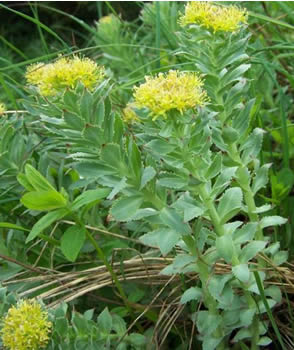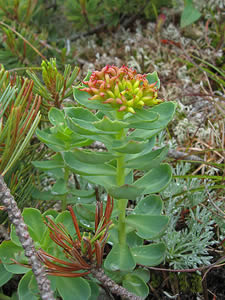Rhodiola Rhodiola rosea
- Common Names
- Rhodiola , Golden Root, Roseroot, Aaron's Rod
- Botanical Name
- Rhodiola rosea
- Syn. Rhodea rosiola , R. kirilowii,
- Family
- CRASSULACEAE
Medicinal Uses & Benefits of Rhodiola
![]() How to Use|
Side Effects |
Plant & Garden|
How to Use|
Side Effects |
Plant & Garden|
- Medicinal Uses: * Chinese
* Depression
* Libido
* Memory/Focus
* Nausea
* Stress
- Properties: * Adaptogens * Aphrodisiac * Cordial * Immunostimulant * Stimulant
- Parts Used: Root
- Constituents: rosavin, rosin, rosarin and salidroside
How to Use: Rhodiola
Rhodiola is an adaptogen, and acts in a similar fashion as ginseng. In traditional medicine, rhodiola root was prepared as a tea, and given in treatment of colds, anemia and to enhance fertility and sexual function. Modern research suggests rhodiola may support memory and focus, and relieve depression. Clinical trials have found Rhodiola rosea roots and rhizomes demonstrated anti-depressive activity in patients with mild to moderate depression, with less drug/herb interaction than the better known St. Johns Wort.1,2
Preparation Methods & Dosage :Teas,capsules and tinctures
Rhodiola Side Effects: Use the smallest recommend dose of rhodiola that provides a benefit when treating depression, or erectile dysfunction. In larger doses it becomes a sedative. Not suitable for bipolar disorders. Do use use while pregnant. 1
Plant Description
- Flowers:Single yellow flower
- Plant Class:Flowering Perennial Plant, dioecious (having separate female and male plants).
- Leaves: Several shoots grow from the same thick root. Shoots reaches 5 to 35 cm in height.
- Fruit:
- Preferred Habitat: High altitudes, arctic regions
- Flowering Season:Flowers once during the arctic summer
- Distribution: Norway, Sweden, Finland, Iceland, China, Mongolia, and Russia, and also of Tibet
Regional Traditions :Traditional Chinese Medicine *
How to Grow Rhodiola
Climate change is expected to lead to loss of medicinal species native to Arctic and alpine regions. Rhodiola rosea of the Canadian Arctic and snow lotus (Saussurea laniceps) of the Tibetan mountains are specifically identified as medicinal species that could face significant threats from climate change.
History and Traditions & Folklore
In Siberian villages, a bouquet of rhodiola roots is still given to couples just prior to marriage to enhance fertility and to ensure the birth of healthy children.- . Special Swedish Rhodiola Extract Shows Benefit in Mild to Moderate Depression in Clinical Trial , HerbClip ABC, (December 14, 2007): In addition to mood elevation, evidence indicates that R. rosea has numerous other benefits, including enhancement of cognitive function, sexual function, and both mental and physical performance under stress. ,

- . A randomized, double-blind, placebo-controlled, parallel-group study of the standardized extract SHR-5 of the roots of Rhodiola rosea in the treatment , Planta Med./ABC, ( November 18, 200): According to the authors, this study is the first to show that rhodiola benefits patients with chronic stress-induced fatigue. Additionally, this study is the first to demonstrate clinically that rhodiola benefits stress-induced disorders by modulating cortisol,













